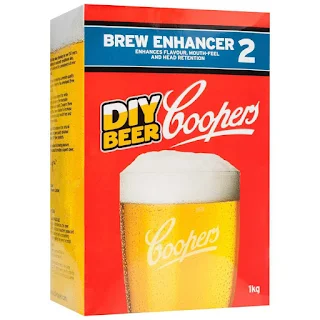Using beer enhancer to make better homebrew beer
The thing about beer is that is that there’s so much variety in style and taste but there is one thing they all have in common:
The so-called ‘mouth feel’ which makes a beer feel like it has 'body'.
Like how a good pint of Guinness feels.
Like a creamy but solid breakfast.
If you simply brewed malt with sugar you will get a beer but your beer’s mouthfeel will be closer to feeling like water. Which is just wrong, as a full-bodied beer enhances the drinking experience!
To get an improved mouthfeel, many beer brewers use an ‘enhancer’ to do exactly what it says it will do – enhance the beer by giving it greater body and mouthfeel.
Beer enhancers are made of basic ingredients, being a mix of fermentable and non-fermentable. They usually contain a mix of dextrose and maltodextrin.
Such beer enhancers work the dextrose serving as the food for the yeast and are thus used in the fermentation process.
The maltodextrin does not ferment and thus forms part of the beer solution giving the beer mouthfeel and a true sense of body. It also has the benefit of allowing the poured beer to have a good head of foam and to retain it.
I have no idea how the science of this part works!
The maltodextrin does not ferment and thus forms part of the beer solution giving the beer mouthfeel and a true sense of body. It also has the benefit of allowing the poured beer to have a good head of foam and to retain it.
I have no idea how the science of this part works!
The combination of dextrose and maltodextrin suits the lighter style beers such as pilsner, draught, and lagers.
If you are brewing an ale or a beer where you desire a full, maltier flavor an enhancer that also has an element of light dry malt extract will be what you need.
This is often simply referred to as DME
Some beer enhancers also have hops added to match the kind of beer style so if you are ordering from an online store, check that the particular enhancer's hops matches the kind of beer you are trying to make.
'Branded' beer enhancers

The Australian beer making company, Coopers, offer two well-known beer enhancers to help achieve these goals.
They are simply known as Brew Enhancer 1
What is the difference between enhancer one and two?
The difference between the two is one suits a lager, the other ales.
You can imagine the salty old brewer that came up with those very telling names!
Coopers include the enhancers with their beer kits
The result was the beer having very little body and the flavor could have been stronger.
Which is what you expect me to report in an article like this eh?
There are some other popular enhancer brands out there too. Muntons, Young's and Copper Tun are well known and trusted by many brewers.
Copper Tun are well known and trusted by many brewers.
Using spraymalt to add body to beer
You may have also heard the word 'spraymalt'. It can be used as an alternative to standard beer enhancer.
Spraymalt is a specially prepared kind of DME
This means a spraymalt beer will be less dry than beers that simply use sugar. Or you can add spraymalt in addition to the sugar for more effect on the taste or your beer.
How to make your own beer enhancer
Of course, you do not need to buy brew enhancer, you can make your own!
If you going to make your own enhancer, here’s some ingredient ratios which you could use as a guide:
Beer style
|
Dextrose
|
Maltodextrin
|
DME
|
Light Beer
|
60%
|
40%
|
0%
|
Ale, more malty beer
|
50%
|
25%
|
25%
|
The quantity to make is is 1Kg per 23 litre brew (which is a standard amount for a fermenter drum).
The beauty of the dextrose is that it is apparently a more favored food of the yeast when compared to ordinary sucrose sugar and so fermentation will commence more quickly.
Whether that makes a difference, I don't know however using too much sugar gives the beer too much a citrus flavor which can be off-putting.
Many beer supply shops will carry the ingredients you need. That way you can get the advantage of buying in bulk so to reduce your brewing costs.
Adding beer enhancer will likely increase the alcohol production of the yeast as well!
The beauty of the dextrose is that it is apparently a more favored food of the yeast when compared to ordinary sucrose sugar and so fermentation will commence more quickly.
Whether that makes a difference, I don't know however using too much sugar gives the beer too much a citrus flavor which can be off-putting.
Many beer supply shops will carry the ingredients you need. That way you can get the advantage of buying in bulk so to reduce your brewing costs.
Adding beer enhancer will likely increase the alcohol production of the yeast as well!
When do I add beer enhancer?
When you are preparing your wort - I do it first and then add the malt extract as I think it all dissolves better in that order. You can add your hops at the same time.
Adding a brew enhancer to your brew does add to the cost per glass somewhat, however, given that enhancers actually really do work (I use them every time I brew), it's my view and that of thousands of other home brewers, that the taste and body improvements are very worth it.
Are beer enhancers cost effective per batch brew?
Adding a brew enhancer to your brew does add to the cost per glass somewhat, however, given that enhancers actually really do work (I use them every time I brew), it's my view and that of thousands of other home brewers, that the taste and body improvements are very worth it.
If your enhancer costs 8 dollars and you make 23 liters, that’s only 35 cents extra per liter.
Naturally, the mileage may vary depending on what brand and at what price you’ve purchased!
If you’re not interested in making your own enhancer but think brand name enhancers are too expensive, there is a happy medium.
Many beer shop suppliers will do the mixing for you and sell you a 1Kg bag of no frills beer enhancer.
Naturally, the mileage may vary depending on what brand and at what price you’ve purchased!
If you’re not interested in making your own enhancer but think brand name enhancers are too expensive, there is a happy medium.
Many beer shop suppliers will do the mixing for you and sell you a 1Kg bag of no frills beer enhancer.

